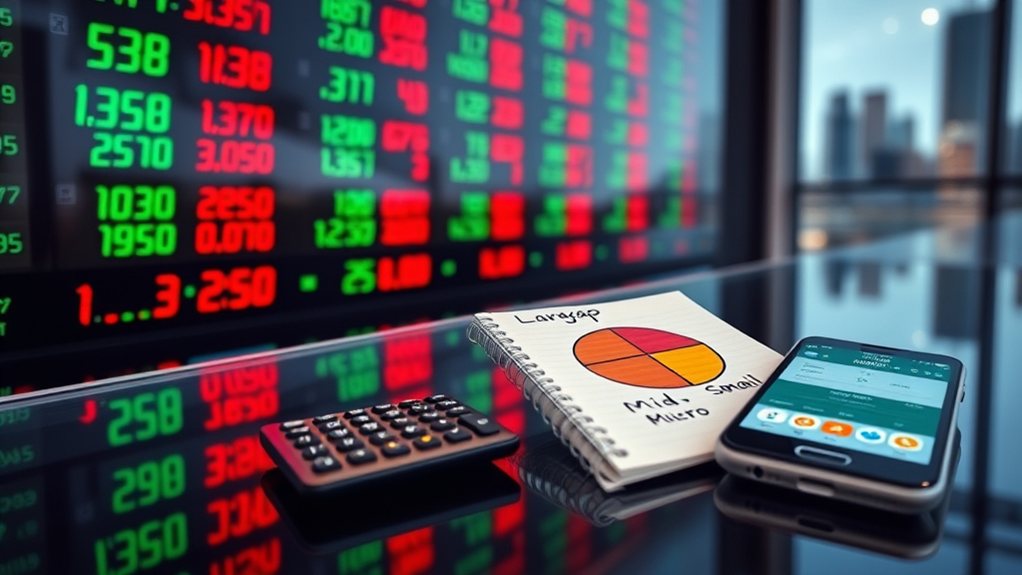Market cap, short for market capitalization, is the total value of a company's outstanding shares of stock. It's calculated by multiplying the current share price by the number of shares available for trading. Companies are categorized as large-cap (over $10 billion), mid-cap ($2-10 billion), or small-cap ($250 million-$2 billion). Market cap helps investors assess a company's size, stability, and potential risk. Different cap sizes offer varying combinations of stability and growth potential.

Market capitalization, or "market cap" for short, is the total dollar value of a company's outstanding shares of stock. It's calculated by multiplying a company's current share price by the total number of shares that are available for public trading. This simple formula provides investors with a snapshot of a company's overall size and value in the marketplace.
Market cap offers a quick snapshot of a company's total value, revealing its economic footprint in the investment landscape.
The calculation of market cap relies on publicly available information. For example, if a company has 10 million outstanding shares and its stock trades at $50 per share, its market cap would be $500 million. Because stock prices change constantly during trading hours, a company's market cap also fluctuates throughout the day.
Market cap serves as a key metric for categorizing companies by size. Large-cap companies typically have a market value exceeding $10 billion. These firms often have established business models and steady revenue streams. Mid-cap companies fall between $2 billion and $10 billion, while small-cap companies range from $250 million to $2 billion. At the extremes, mega-cap giants exceed $200 billion, and micro-cap companies sit below $250 million.
Investors use market cap to assess risk and potential returns. Generally, large-cap companies are considered more stable but might offer slower growth. Small-cap companies often present higher growth potential but come with increased volatility and risk. These classifications help investors build diversified portfolios aligned with their financial goals and risk tolerance.
Several factors influence a company's market cap. Beyond daily stock price movements, actions like issuing new shares or repurchasing existing ones directly affect the calculation. Market sentiment, quarterly financial results, industry trends, and broader economic conditions all play important roles in determining how investors value a company. It's important to understand that market cap is not the same as enterprise value, which provides a better acquisition calculation for potential mergers and buyouts. Investors often analyze enterprise value alongside market cap to account for a company's debt and cash position using the formula EV = (Market cap + Debt) – Cash.
Despite its widespread use, market cap has notable limitations. It doesn't account for a company's debt load or cash reserves—factors that greatly impact a firm's true financial health. A company might have a high market cap but also carry substantial debt, making it less financially sound than its valuation suggests. Market cap can also be influenced by speculation rather than fundamental business performance.
Market cap guides many investment strategies and decisions. It determines which companies qualify for inclusion in major stock indexes. Investment funds often focus on specific market cap ranges, and institutional investors may have policies about which size companies they can invest in. Financial analysts also use market cap for comparing companies within the same industry.
Understanding market cap provides investors with an essential tool for evaluating companies and making informed decisions. While it's not a perfect measure of a company's worth, it remains one of the most accessible and widely referenced metrics in the financial markets.
Frequently Asked Questions
How Often Is Market Cap Recalculated?
Market cap is recalculated continuously during trading hours, updating with every stock price change.
Major financial websites refresh this data every few minutes, while high-frequency trading platforms update multiple times per second.
Official figures are typically finalized at market close.
Quarterly and annual adjustments account for changes in outstanding shares.
Special events like mergers or IPOs trigger immediate recalculations.
Update frequency varies based on trading volume and company size.
Can Market Cap Predict Stock Performance?
Market cap alone can't reliably predict stock performance.
Studies show only weak connections between company size and short-term returns. While large-cap stocks typically show more stability, small-caps have historically performed better over long periods.
Experts note that other factors matter more, including earnings growth, industry trends, and management decisions. For a complete picture, investors need to evaluate market cap alongside metrics like P/E ratios and cash flow.
What's the Difference Between Market Cap and Enterprise Value?
Market cap only measures a company's equity value based on share price and outstanding shares.
Enterprise value (EV) offers a more complete picture by including debt and cash. While market cap ignores a company's debt burden, EV adds debt and subtracts cash.
Market cap is simpler to calculate and commonly used to classify companies by size. EV is preferred for comparing companies with different debt levels.
Why Do Some Investments Ignore Market Cap?
Some investments ignore market cap because they focus on other valuation methods.
Value investors might prefer price-to-earnings ratios or book value.
Income-focused strategies prioritize dividend yields instead.
Behavioral biases like familiarity and confirmation bias can lead investors to overlook market size.
Sector-specific factors, such as growth potential or regulatory environment, often matter more in certain industries.
Some strategies, like momentum or contrarian approaches, don't consider company size at all.
How Do Stock Splits Affect Market Cap?
Stock splits don't change a company's market capitalization.
When a company splits its stock, it increases the number of shares while the price drops proportionally.
For example, in a 2-for-1 split, shareholders get twice as many shares, but each share costs half as much.
The math works out the same: the company's total value stays identical.
It's like cutting a pizza into more slices without changing the pizza's size.










